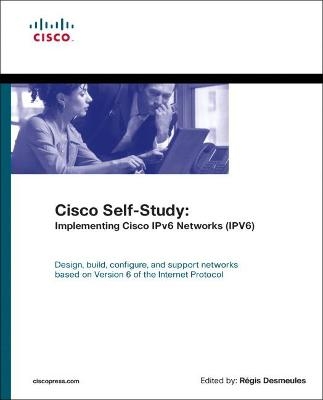
Cisco Self-Study
Cisco Press (Verlag)
978-1-58714-286-4 (ISBN)
- Keine Verlagsinformationen verfügbar
- Artikel merken
Coverage includes:
Overview of history and motivations behind the new protocol, including the limitations of the IPv4 address space, Network Address Translation (NAT), fast growth of the Internet routing table, international issues, mobility, security, and many other topics
Header format, addressing, Path MTU Discovery (PMTUD), IPv6 over link-layer technologies, Extended Unique Identifier-64-bit (EUI-64) format, Internet Control Message Protocol Version 6 (ICMPv6), autoconfiguration, neighbor discovery protocol, Duplicate Address Detection (DAD), and use of DNS with IPv6
Comparison with BGP4+, RIPng, IS-IS for IPv6, and OSPFv3 with Cisco IOS(r) Software routing references and examples
Transitioning from and co-existing with IPv4 using Dual Stack, configured tunnel, generic routing encapsulation (GRE), 6to4, 6to4 Relay, Intra-Site Automatic Tunnel Addressing Protocol (ISATAP), and Network Address Translation-Protocol Translation (NAT-PT) configurations
Enabling, configuring, and operating a Cisco router with IPv6 addresses, prefixes, IPv6 ACLs, IPv6-enabled routing protocols, CEFv6, and several coexistence mechanisms
Host-router interaction with Microsoft Windows, Solaris, FreeBSD, Linux, and Tru64 UNIX Preview of Internet IPv6 and address allocation on 6Bone
Deploying production IPv6 connectivity in enterprise networks using prefixes allocated by ARIN, RIPE, and APNIC
With the proliferation of Internet devices that require a globally unique host address such as handhelds, 3G phones, and other wireless devices, the supply of Internet addresses available will soon be exhausted. Cisco Self-Study: Implementing Cisco IPv6 Networks (IPV6) shows you how to use Version 6 of the Internet Protocol to stay ahead of the curve, safeguard against running out of address space, avoid awkward address-expansion efforts, and apply the power of the new Internet to meet your needs over the coming decades.
Complete with practical examples that show the real-world application of IPv6, Cisco Self-Study: Implementing Cisco IPv6 Networks (IPV6) presents in-depth technical coverage of designing, configuring, deploying, and debugging IPv6 on Cisco routers. Within, you'll find strategies for management, integration, and international implications. To help you remember key concepts, each chapter ends with challenging review questions that test your knowledge of the subject matter. Whether you are searching for a comprehensive reference to the new version of the Internet Protocol or require a solutions-based implementation guide based on official Cisco content, Cisco Self-Study: Implementing Cisco IPv6 Networks (IPV6) is your complete networking resource for this valuable and inevitable technology.
Cisco Self-Study: Implementing Cisco IPv6 Networks (IPV6) is part of a recommended learning path from Cisco Systems that can include simulation and hands-on training from authorized Cisco Learning Partners and self-study products from Cisco Press. To find out more about instructor-led training, e-learning, and hands-on instruction offered by authorized Cisco Learning Partners worldwide, please visit www.cisco.com/go/authorizedtraining.
This volume is in the Self-Study Guide Series from Cisco Press. Books in this series provide Cisco authorized, self-study solutions to help networking professionals understand technology implementations and prepare for the Cisco Career Certification examinations.
Régis Desmeules is an independent consultant specializing in IPv4, IPv6, network architecture and design, security, multimedia, Cisco routers, UNIX, and Microsoft implementations. He has developed and taught courses related to IPv4, IPv6, multimedia over IP, security, DNS, and MobileIP. Régis consulted extensively with Viagénie, Inc., where he participated in IPv6 projects such as the deployment of IPv6 backbones on CA*net2 and CA*net3, the development of Freenet6.net, the creation of a stealth IPv6 DNS root server, the IPv6 Internet exchange called 6TAP, and the network game Quake over IPv6.
Introduction.
I. OVERVIEW OF AND JUSTIFICATION FOR IPV6.
1. Introduction to IPv6.
Rationale for IPv6. IPv4 Address Space6. IPv4 Address Space Exhaustion. History of IPv6. IPv5. Network Address Translation. IPv6 Features. Summary. Review Questions. References.
II. IPV6 DESIGN.
2. IPv6 Addressing.
IP Header. Addressing. Addressing Architecture of IPv6. Configuring IPv6 on Cisco IOS Software Technology. Summary. Configuration Exercise: Configuring an IPv6 Network Using Cisco Routers. Review Questions. References.
3. IPv6 in Depth.
Internet Control Message Protocol for IPv6 (ICMPv6). Path MTU Discovery (PMTUD) for IPv6. Neighbor Discovery Protocol (NDP). Domain Name System (DNS). Securing the Network Using IPv6 Access Control Lists (ACLs). Cisco IOS Software IPv6 Tools. Dynamic Host Configuration Protocol for IPv6 (DHCPv6). IPv6 Security. Mobile IP. Summary. Configuration Exercise: Managing Prefixes on the IPv6 Network Using Cisco Routers. Review Questions. References.
4. Routing on IPv6.
Introduction to Routing with IPv6. Static IPv6 Routes. EGP Protocols for IPv6. IGP Protocols for IPv6. Cisco Express Forwarding for IPv6. Summary. Case Study: Configuring Static Routes and Routing Protocols with Cisco. Review Questions. References.
III. IPV4 AND IPV6: COEXISTENCE AND INTEGRATION.
5. IPv6 Integration and Coexistence Strategies.
Dual Stack. Tunneling IPv6 Packets Over Existing IPv4 Networks. IPv6-Only-to-IPv4-Only Transition Mechanisms. Summary. Case Study: Using IPv6 Integration and Coexistence Strategies with Cisco. Review Questions. References.
6. IPv6 Hosts Internetworking with Cisco.
IPv6 on Microsoft Windows. IPv6 on Solaris. IPv6 on FreeBSD. IPv6 on Linux. IPv6 on Tru64 UNIX. Other Host Implementations That Support IPv6. Summary. Case Study: Internetworking IPv6 Hosts with Cisco. Review Questions. References.
IV. THE IPV6 BACKBONE.
7. Connecting to the IPv6 Internet.
6bone. IPv6 Internet. Connecting to the Production IPv6 Internet. Industry Support and Trends. Summary. Review Questions. References.
V. APPENDIXES.
Appendix A. Cisco IOS Software IPv6 Commands.
Appendix B. Answers to Review Questions.
Appendix C. RFCs Related to IPv6.
Glossary.
Index.
| Erscheint lt. Verlag | 9.3.2011 |
|---|---|
| Verlagsort | Indianapolis |
| Sprache | englisch |
| Maße | 189 x 229 mm |
| Gewicht | 850 g |
| Themenwelt | Mathematik / Informatik ► Informatik ► Netzwerke |
| Informatik ► Weitere Themen ► Zertifizierung | |
| ISBN-10 | 1-58714-286-4 / 1587142864 |
| ISBN-13 | 978-1-58714-286-4 / 9781587142864 |
| Zustand | Neuware |
| Informationen gemäß Produktsicherheitsverordnung (GPSR) | |
| Haben Sie eine Frage zum Produkt? |
aus dem Bereich


